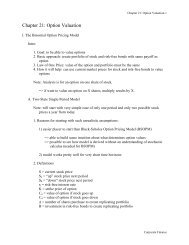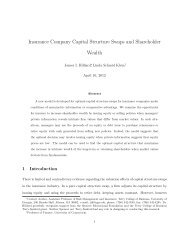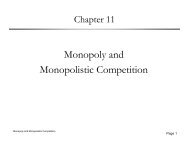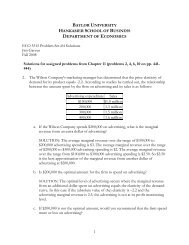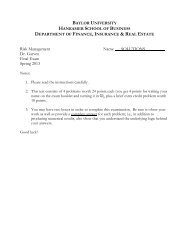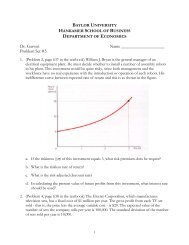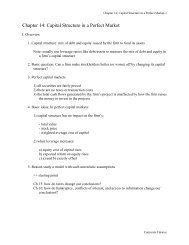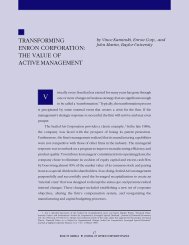Chapter 4: The Time Value of Money ( )n
Chapter 4: The Time Value of Money ( )n
Chapter 4: The Time Value of Money ( )n
Create successful ePaper yourself
Turn your PDF publications into a flip-book with our unique Google optimized e-Paper software.
<strong>Chapter</strong> 4: <strong>The</strong> <strong>Time</strong> <strong>Value</strong> <strong>of</strong> <strong>Money</strong><br />
Big Picture: Cash flows at different points <strong>of</strong> time are in different units<br />
<strong>Chapter</strong> 4: <strong>The</strong> <strong>Time</strong> <strong>Value</strong> <strong>of</strong> <strong>Money</strong>-1<br />
=> can’t compare or combine unless convert to the same units (same point in time)<br />
I. Solving time value <strong>of</strong> money problems<br />
A. Systematic steps<br />
1. Draw a timeline<br />
2. Identify the pattern <strong>of</strong> the cash flow:<br />
- Perpetuity – series <strong>of</strong> regular cash flows that continue forever<br />
- Annuity – series <strong>of</strong> regular cash flows that stop<br />
- Single cash flow – one cash flow<br />
3. Write down appropriate equation, plug in what know, solve for any one variable don’t<br />
know<br />
4. Repeat steps 2 and 3 as <strong>of</strong>ten as necessary to solve the problem<br />
B. <strong>The</strong> <strong>Time</strong>line<br />
1. I do all time lines in years<br />
2. I vary size <strong>of</strong> tick marks to make timelines easier to read<br />
Relative size <strong>of</strong> tick marks (from smallest to largest): monthly, semiannual, annual, 5year,<br />
10-year<br />
Note: use as few “sizes” as possible<br />
C. Basic <strong>Time</strong> <strong>Value</strong> <strong>of</strong> <strong>Money</strong> Equations<br />
1. Single Cash Flow<br />
a. Future <strong>Value</strong>: n FV C 1 r<br />
(4.1)<br />
b. Present <strong>Value</strong>:<br />
t<br />
PV<br />
t<br />
1<br />
C<br />
n<br />
n r<br />
(4.2)<br />
Corporate Finance
2. Perpetuity (Present <strong>Value</strong> Only)<br />
PV t<br />
<strong>Chapter</strong> 4: <strong>The</strong> <strong>Time</strong> <strong>Value</strong> <strong>of</strong> <strong>Money</strong>-2<br />
C<br />
(4.10)<br />
r g<br />
Note: if constant cash flow, g = 0.<br />
3. Annuity<br />
a. Present <strong>Value</strong>:<br />
PV<br />
t<br />
N<br />
b. Future <strong>Value</strong>: FV r<br />
1g D. General notes on TVM equations<br />
t<br />
<br />
N<br />
C<br />
<br />
1+g<br />
<br />
1 - <br />
(4.11)<br />
r-g <br />
<br />
1+r<br />
<br />
C<br />
N<br />
1 <br />
(4.A)<br />
r g<br />
1) C = 1 st cash flow in series (may be only cash flow)<br />
2) r = interest rate<br />
3) g = growth rate <strong>of</strong> cash flows (after 1 st one) in a series <strong>of</strong> cash flows<br />
Note: g = 0 for constant cash flows and g < 0 for shrinking cash flows<br />
4) n = number <strong>of</strong> periods moving a cash flow into the future or towards the present<br />
5) N = number <strong>of</strong> cash flows in a series <strong>of</strong> cash flows<br />
6) Where end up on time-line<br />
a) PV <strong>of</strong> single cash flows: n periods before the cash flow<br />
b) FV <strong>of</strong> single cash flows: n periods after the cash flow<br />
c) PV <strong>of</strong> a series (growing annuity or growing perpetuity): one period before first<br />
cash flow<br />
Note: period defined by time between cash flows<br />
d) FV <strong>of</strong> series (growing annuity): date <strong>of</strong> last cash flow<br />
7) I add a “t” subscript on PV and FV to keep track <strong>of</strong> where I end up on the timeline<br />
after each step<br />
Corporate Finance
II. Examples<br />
A. Practicing “n” and “N”<br />
<strong>Chapter</strong> 4: <strong>The</strong> <strong>Time</strong> <strong>Value</strong> <strong>of</strong> <strong>Money</strong>-3<br />
1. Assume you plan to deposit $100 per year into an account. You will make your first<br />
deposit five years from today and your final deposit eleven years from today.<br />
Q: Assume you want to calculate the balance in your account right after your final<br />
deposit. Which equation would you use? What would you use for “N” or “n”?<br />
Steps: 1) draw (or modify) timeline, 2) identify pattern <strong>of</strong> cash flow, 3) figure out<br />
if need to calculate present or future value <strong>of</strong> payment(s), 4) identify equation<br />
or equations need to use, 5) figure out “N” or “n”.<br />
A: Equation = future value <strong>of</strong> an annuity (4.A); N = 7<br />
Q: Assume you that after making your final deposit, you leave the account alone until<br />
15 years from today. What equation would you use and what would you use for<br />
“N” or “n” when calculating the balance <strong>of</strong> your account?<br />
Steps: 1) draw (modify) timeline, 2) identify pattern <strong>of</strong> cash flow, 3) figure out if<br />
need to calculate present or future value <strong>of</strong> payment(s), 4) identify equation or<br />
equations need to use, 5) figure out “N” or “n”.<br />
A: Equation = future value <strong>of</strong> a single sum (4.1); n = 4<br />
2. Assume you had planned to deposit $100 per year into an account with the first deposit<br />
being made five years from today and the final deposit occurring eleven years from<br />
today. However, you have now decided to simply deposit an equivalent into an<br />
account today.<br />
Q: What equation would you use to calculate the present value <strong>of</strong> the payments?<br />
What would you use for “N” or “n”? Where do you end up on the time line?<br />
Steps: 1) timeline, 2) pattern <strong>of</strong> cash flows, 3) present or future value, 4) equation<br />
or equations, 5) figure out “N” or “n”.<br />
A: Equation = present value <strong>of</strong> an annuity (4.11); N = 7; end up at t = 4.<br />
Q: Once you solve for the value at t = 4, how would you calculate the equivalent<br />
present value today (equation, N/n)?<br />
Steps: 1) timeline, 2) pattern <strong>of</strong> cash flows, 3) present or future value, 4) equation<br />
or equations, 5) figure out “N” or “n”.<br />
A: Equation = present value <strong>of</strong> single cash flow (4.2), n = 4<br />
Corporate Finance
<strong>Chapter</strong> 4: <strong>The</strong> <strong>Time</strong> <strong>Value</strong> <strong>of</strong> <strong>Money</strong>-4<br />
3. Assume you have just deposited $1000 into a savings account. You plan to make a<br />
series <strong>of</strong> annual withdrawals from the account starting eight years from today and<br />
continuing through 18 years from today.<br />
Q: What equations will you need to use to solve for the amount you can withdraw?<br />
What will you use for N or n in each equation?<br />
Steps: 1) timeline, 2) pattern <strong>of</strong> cash flows, 3) present or future value, 4) equation<br />
or equations, 5) figure out “N” or “n”.<br />
A: 1) future value <strong>of</strong> single cash flow (4.1), n = 7; 2) present value <strong>of</strong> an annuity<br />
(4.11), N = 11<br />
4. You have just made the first <strong>of</strong> a series <strong>of</strong> annual deposits <strong>of</strong> $100 each into a savings<br />
account. You plan to make additional deposits through four years from today. Ten<br />
years from today, you plan to make the first <strong>of</strong> a series <strong>of</strong> annual withdrawals from<br />
your account. Your final withdrawal will occur 18 years from today.<br />
Q: What equations will you need to use to solve for the amount <strong>of</strong> your first<br />
withdrawal? What would you use for N or n in each equation?<br />
Steps: 1) timeline, 2) pattern <strong>of</strong> cash flows, 3) present or future value, 4) equation<br />
or equations, 5) figure out “N” or “n”.<br />
A: 1) future value <strong>of</strong> annuity (4.A), N = 5; 2) future value <strong>of</strong> a single cash flow, n<br />
= 5; 3) present value <strong>of</strong> an annuity (4.11), N = 9<br />
Q: What equations will you need to use to solve for the amount <strong>of</strong> your first<br />
withdrawal if you first calculate the present value <strong>of</strong> the deposits and solve for the<br />
future value <strong>of</strong> the withdrawals?<br />
Steps: 1) timeline, 2) pattern <strong>of</strong> cash flows, 3) present or future value, 4) equation<br />
or equations, 5) figure out “N” or “n”.<br />
A: 1) present value <strong>of</strong> annuity (4.11), N = 5; 2) future value <strong>of</strong> a single cash flow,<br />
n = 19; 3) future value <strong>of</strong> annuity, N = 9<br />
Corporate Finance
B. More complex problems<br />
<strong>Chapter</strong> 4: <strong>The</strong> <strong>Time</strong> <strong>Value</strong> <strong>of</strong> <strong>Money</strong>-5<br />
1. Upon retirement 35 years from today, you would like to make your first <strong>of</strong> 15 annual<br />
withdrawals from your savings account. You would like for the first withdrawal to be<br />
$180,000 and would like to be able to increase your withdrawals by 5% per year in<br />
order to allow for inflation. How much would you have to deposit today to achieve<br />
your goal if your account pays 8.5% per year? What is the size <strong>of</strong> your second<br />
withdrawal and your final withdrawal?<br />
Steps: 1) timeline, 2) pattern <strong>of</strong> cash flows, 3) present or future value, 4) equation or<br />
equations, 5) fill in known variables and solve for unknown variable, 6) make<br />
sure know where end up on timeline.<br />
Deposit today:<br />
15<br />
180,<br />
000 1.<br />
05 <br />
PV <br />
34 1 - 1,<br />
998,<br />
022.<br />
07<br />
. 085-.<br />
05 <br />
<br />
1.<br />
085 <br />
<br />
Steps: 2) pattern (single cash flow), 3) equation, 4) fill in<br />
1,<br />
998,<br />
022.<br />
07<br />
PV0 <br />
124,<br />
735.<br />
24<br />
34<br />
1.<br />
085<br />
<br />
Second withdrawal:<br />
Steps: 2) pattern (single), 3) equation, 4) fill in<br />
C36 = 180,000(1.05) = 189,000<br />
Final withdrawal:<br />
Steps: 2) pattern (single), 3) equation Q: PV or FV?<br />
C49 = 180,000(1.05) 14 = 356,387.69<br />
2. Plan to deposit $100 into a savings account 5 years from today. <strong>The</strong>reafter you plan to<br />
make annual deposits that grow by 3% per year. How much is in your account after<br />
you have made 7 total deposits if the account pays 9% per year? What is size <strong>of</strong> 7 th<br />
deposit?<br />
Steps: 1) timeline, 2) pattern <strong>of</strong> cash flows, 3) present or future value, 4) equation or<br />
equations, 5) fill in known variables and solve for unknown variable, 6) make<br />
sure know where end up on timeline.<br />
7 1. 09<br />
1. 03<br />
996.<br />
94<br />
100 7<br />
FV11 <br />
<br />
. 09 . 03<br />
Steps: 2) pattern <strong>of</strong> cash flow (single), 3) write down equation; Q: PV or FV?<br />
CF11 = 100(1.03) 6 = 119.41<br />
Corporate Finance
<strong>Chapter</strong> 4: <strong>The</strong> <strong>Time</strong> <strong>Value</strong> <strong>of</strong> <strong>Money</strong>-6<br />
3. Assume that you have just deposited $500 into an account that pays an interest rate <strong>of</strong><br />
8% per year. You plan to make equal annual withdrawals from this account with the<br />
first withdrawal coming 5 months from today and the final withdrawal coming 5<br />
years and 5 months from today. How large can you make each <strong>of</strong> your withdrawals?<br />
Steps: 1) timeline, 2) pattern <strong>of</strong> cash flows, 3) present or future value, 4) equation or<br />
equations, 5) fill in known variables and solve for unknown variable, 6) make<br />
sure know where end up on timeline.<br />
PV<br />
t<br />
PV t<br />
<br />
C<br />
r-g<br />
<br />
1+g<br />
<br />
1 -<br />
<br />
<br />
1+r<br />
<br />
C <br />
1 <br />
1 -<br />
<br />
<br />
. 08<br />
1.<br />
08 <br />
N<br />
6<br />
<br />
<br />
<br />
<br />
<br />
<br />
<br />
<br />
Q: Where end up on the timeline when take present value <strong>of</strong> the withdrawals?<br />
=> 7 months ago<br />
=> need to figure out equivalent 7 months ago <strong>of</strong> $500 today (so can solve for<br />
C)<br />
Steps: 2) pattern (single), equation; Q: PV or FV?<br />
PV 7 mo<br />
<br />
500<br />
7 12<br />
1. 08<br />
478.<br />
05<br />
<br />
C 1 <br />
PV <br />
7mo 478.<br />
05 <br />
<br />
1 => C = 103.41<br />
6<br />
. 08 1.<br />
08 <br />
4. Assume you deposit $1000 in an account that earns an interest rate <strong>of</strong> 6% per year.<br />
You plan to make annual withdrawals from your account beginning four years from<br />
today. Your plan for your first withdrawal to equal $59.55 and for your subsequent<br />
withdrawals to continue forever. At what rate can your withdrawals grow?<br />
Steps: 1) timeline, 2) pattern <strong>of</strong> cash flows, 3) present or future value, 4) equation or<br />
equations, 5) fill in known variables and solve for unknown variable, 6) make<br />
sure know where end up on timeline.<br />
FV3 = 1000(1.06) 3 = 1191.02<br />
59.<br />
55<br />
1191 . 02 <br />
. 06 g<br />
=> g = .01<br />
Corporate Finance



